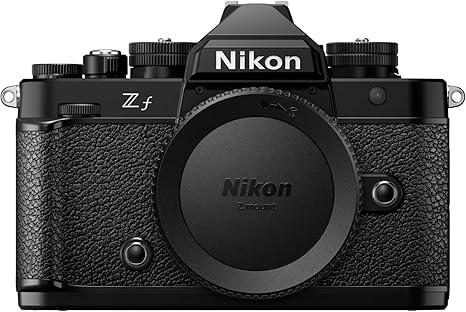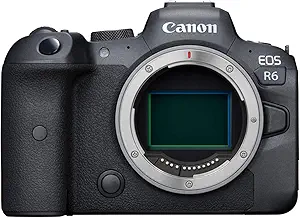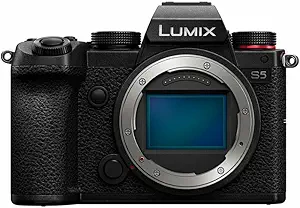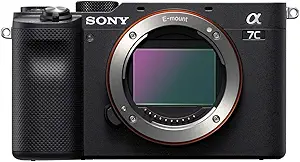A full-frame camera will often make it simpler to work in uncontrolled lighting circumstances, achieve more bokeh or background blur, and capture cleaner photographs with better dynamic range, even if a crop sensor camera may still provide excellent results. The benefits of a full-frame sensor make them worthwhile for those who are serious about photography, even if most people don’t really require one. Keep in mind that full-frame cameras are normally more expensive and less portable than their crop-sensor counterparts; lenses are also frequently larger and more expensive. However, as more and more reasonably priced devices become available at various price points, the entrance barrier is decreasing.
Table of Contents
- No 1 Nikon Z f
- No 2 Nikon Z 5
- No 3 Canon EOS R6 Mark
- No 4 Panasonic LUMIX S5
- No 5 Sony A7C
Top 5 Best Full Frame Mirrorless Cameras In 2025
No 1 Nikon Zf

The Nikon ZF is an elegant tribute to the company’s vintage film cameras, fusing cutting-edge mirrorless technology with vintage aesthetics. Its design instantly grabs attention with a sturdy magnesium body that is strikingly similar to Nikon’s iconic FM2, complete with dials for ISO shutter speed and exposure compensation.
This vintage look is more than just a gimmick, though, as it provides a tactile shooting experience that many photographers long for and enables precise manual control. Beneath this nostalgic exterior, however, is a modern mirrorless powerhouse, thanks to its 24.5 megapixel full-frame sensor, which is identical to.
Together with Nikon’s X6 processor, the Nikon Z62 produces clear, detailed photos with a great dynamic range. It also has rapid focusing, exceptional lowlight performance, and the ability to capture K UHD video, making it suitable for both photographers and videographers. The Nikon ZF’s ability to blend form and function is one of its most notable qualities.
It preserves modern amenities while evoking the elegance of a bygone period. Particularly for content producers, vloggers, and street photographers who need framing versatility, the V angle touchscreen is a great feature. For those who seek a powerful camera without the bulk, the camera’s small size and reasonably light construction make it the ideal travel companion.
With five AIS in body image stabilization, Ibis handheld photography becomes even smoother, lowering the chance of damage Shake in pictures and videos when combined with The growing range of Zont lenses from Nikon The ZF is a completely contemporary instrument that delivers both style and substance for professionals and hobbyists who value the blending of the old and the new. It is not simply a camera with a vintage aesthetic.
Pros
- Stunning industrial design
- Large, sharp EVF
- 3D Tracking autofocus with subject detection
- Quickly switches between color and black-and-white modes
- Magnesium body with dust and splash protection
- 5-axis IBIS supports multi-shot sampling
- Dual memory card slots
Cons
- Doesn’t get dial-driven control right
- Shallow grip not ideal for bulky primes
- Doesn’t come in silver
No 2 Nikon Z 5

The Nikon Z5 is an impressive entry-level full-frame mirrorless camera that delivers exceptional image quality and versatility making it a fantastic IC option for both photography enthusiasts and professionals looking to explore the mirrorless realm.
The Z5’s 24.3 MPC sensor, which creates crisp, detailed pictures with a great dynamic range, is one of its best characteristics. When combined with Nikon’s dependable X6 image processor, the camera handles low light settings quite well, providing anative ISO range of 100 to 51,200. The Z 5S’s performance is always high, so you can take clear, colorful pictures whether you’re photographing landscapes, portraits, or even things that move quickly.
Its 273 Point autofocus system is Snappy and accurate ensuring you never miss a moment while the continuous shooting speed is somewhat Limited at 4.5 frames per second this compromise is acceptable given thecamera’s price point Although the Z5 is one of Nikon’s more reasonably priced full-frame models, it also excels in terms of ergonomics and build quality.
It has a strong, weatherproof body that feels high-end and well made. The camera’s lightweight and compact design make it perfect for travel or outdoor photography, and its comfortable grip allows for extended usage.
the 3.2 and tilting touchscreen provides ease of control and navigation and the EV electronic viewfinder offers a crisp and clear preview of your shots Another noteworthy feature is the two SD card slots, which are uncommon but much valued in cameras of this kind, guaranteeing plenty of.
storage and backup choices. Although the z5’s 4K video recording is cropped, which may be a drawback for videographers, the Z5 offers excellent value for photographers wishing to transition to full-frame photography thanks to its combination of excellent still image performance, user-friendly handling, and Nikon’s expanding zound lens ecosystem.
Pros
- Excellent image quality.
- Amazing ergonomics.
- Great battery life.
- Sturdy and weather-sealed.
Cons
- Not especially portable.
No 3 Canon EOS R6 Mark

The Canon USR 6 Mark II is a Powerhouse of a camera designed for both photographers and videographers looking to push their creativity to new heights with its 24.2 MP full-frame SOS sensor this camera delivers outstanding image quality vibrant colors and impressive lowlight performance With Lightning, the upgraded dual pixel Cesa F2 technology is revolutionary.
Whether you’re shooting portraits, landscapes, or fast-moving action, the R Six Mark II always produces beautiful, crisp images because to its quick focusing and improved subject tracking, even in difficult situations.
It is a versatile tool for wildlife and sports photography because of its 12 frames per second mechanical shutter, which can reach 40 frames per second with the electronic shutter. Additionally, its 5 AIS and Body Image stabilization reduce motion blur, making handheld shooting more dependable and smooth. When it comes to video, the Canon 6 Mark I really shines because it supports 4K UHD video recording up to 60p using the full width of the sensor, producing stunning.
Detail and clarity It differs from its predecessor in that it can shoot 6K raw externally, providing professional videographers with a degree of versatility. Additionally, Canon fixed the R-6’s overheating problems, making this version more dependable for longer shots.
The Canon ESR 6 Markai is a top-tier option for content creators who require versatility and performance in both photography and videography because of its ergonomic design, user-friendly controls, and long-lasting weather-sealed body. Its advanced features, such as Focus breathing correction clog 3 and in-camera HDR recording, further improve the camera’s video capabilities.
Pros
- Fantastic image quality
- Well-built, weather-sealed body
- Quick burst shooting
- Remarkable autofocus
Cons
- Not especially portable
- Slow buffer empty time
No 4 Panasonic Lumix S5

At the heart of the Panasonic Lumix s52’s notable advancements in the mirrorless camera market are a new 24.2 megapixel full-frame sensor that produces incredibly detailed and high-quality photographs for both photographers and filmmakers. High dynamic range and rich color richness Because of its dual native ISO, the S52 excels in low light.
Technology that reduces noise while preserving details and difficult settings Another highlight is its 5-axis and body image stabilization, which guarantees steady shots whether you’re holding the camera for stills or recording smooth handheld video.
The updated autofocus system now has phase detection, which greatly improves its tracking capabilities for subjects that move quickly. This makes it a great option for action photography, wildlife photography, and fast-paced event coverage for content creators and filmmakers. With its remarkable variety of video functions, the S52 allows for 6K video recording at 30 frames per second, giving post-production flexibility.
In addition to supporting 4K 60 frames per second video without drop, which guarantees wide angle views stay intact, the camera is particularly useful for cropping and stabilizing footage. For those who want the most flexibility over color grading, Panasonic’s Vlog profile is available. The camera’s limitless recording capability is a boon for lengthy filming sessions, and a cooling fan makes sure the camera doesn’t overheat.
One of its highlights is the real-time lot program, which lets filmmakers use their favorite color schemes right in the camera. The Lumix S52 fills the gap between film and photography For designers who want a single gadget that is proficient in two fields, Mak makes it a flexible tool. This camera provides a combination of features and performance quality that make it a worthwhile purchase, regardless of whether you’re an enthusiast or a professional.
Pros
- Excellent video quality
- Wide selection of inputs and outputs
- 10-bit 4:2:2 internal recording
Cons
- Autofocus tracking isn’t the most reliable
No 5 Sony A7C

The Sony Alpha 7 C2 is a great option for photographers and videographers who value mobility without compromising quality because of its remarkable combination of portability and performance.
At first glance, the alpha cc2’s small size and lightweight design make it one of the lightest full-frame mirrorless cameras available. It weighs just 1.12 lbs.
A 33m MP full-frame Zuro sensor that produces amazing picture quality with breathtaking detail and dynamic range is one of the great characteristics of the Alpha 7 C2. With complete pixel readout and no pixel binning, it can record 4K video at 60 frames per second.
Crystal Clear footage Even in difficult situations, tracking objects is made simple by the quick and dependable 759 phase detection points of the improved autofocus system. For content makers who are always on the run, the body stabilization technology also enables fluid handheld filming.
The ideal harmony between adaptability and usability is what really distinguishes the Sony Alpha 7 C2 from its rivals. The camera has a user-friendly UI that allows for customizationcontrols that make it accessible to both season professionals and those just entering the full-frame market its VR angle.
Touchcreen is a fantastic tool for vloggers and independent producers since it gives them the freedom to film in confined locations and at various angles. The longer battery life, which enables longer shooting sessions without frequent pauses, is another plus. Connectivity possibilities such.
The Alp7 C2 is a true powerhouse and a small package perfect for professional video production and trip street photography, offering an exceptional blend of features and performance. Bluetooth Wi-Fi and USBC make file transfers and remote control simple.
Pros
- Full-frame sensor in APS-C sized body
- 5-axis IBIS
- Forward-facing touch LCD
- Superlative tracking autofocus
- 10fps continuous drive
- 4K video with flat and HDR looks available
- Best-in-class battery life
Cons
- EVF is on the small side
- Doesn’t have Sony’s new menu system
- Touch functions could be more robust
- Omits front command dial and focus joystick
- 4K tops out at 30fps
All Reviews.
According to our suggestions, the finest mirrorless full-frame cameras available right now are those that most people can purchase based on their demands and price range. Price, visitor reviews, and availability are all taken into consideration (no hard-to-find or nearly-depleted cameras in the U.S.).
Here is a compilation of all our reviews for full-frame mirrorless cameras with interchangeable lenses so you can make your own decision. Be careful not to get caught up in the details. No single camera is flawless. Your choice will be more influenced by your shooting habits, ergonomic preferences, and personal taste.
Please be aware that we may receive a commission if you buy something after clicking on the links in our stories. This helps to fund our work. Thank you for your support and attention. Feel free to look around further to find out more about how these commissions support our work. Top Great Reviews

